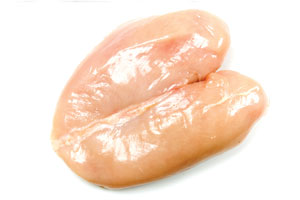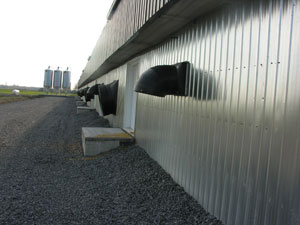
PIC Update: January 2009
By PIC
Features Business & Policy TradeEffect of Nutrition on Meat Quality
Poultry meat quality is receiving considerable attention recently due
to the emergence of problems associated with poor water holding
capacity, poor texture, and pale colour. Meat with these
characteristics is termed PSE (pale, soft, exudative).
The quality of poultry is receiving a lot of attention from researchers these days
 |
| FACTORS AFFECTING QUALITY Dr. Mirko Betti and his research team at the University of Alberta have been investigating the impact of a range of dietary energy and protein levels on poultry meat quality. |
Poultry meat quality is receiving considerable attention recently due to the emergence of problems associated with poor water holding capacity, poor texture, and pale colour. Meat with these characteristics is termed PSE (pale, soft, exudative). According to several studies, the estimation of PSE in broilers ranges between five and 30 per cent in commercial operations, posing problems for both value-added processing and consumer satisfaction. Although the direct cause is known to be attributed to protein denaturation (a process in which a protein’s structure is altered, causing the protein to become biologically inactive), the ultimate cause of PSE meat is not clear. In order to manage the problem, the industry needs information on what factors contribute to it.
Major factors in the development of PSE meat are thought to include a variety of stressors pre-slaughter and genetic selection for fast growth, leading to muscle abnormalities and meat quality defects. However, studies have demonstrated that genetic selection for fast growing birds have no important effects on broiler breast meat quality. Nutrition also comes into play, and the severity of PSE meat may be modulated by nutrition or possibly feed formulation.
Feeding strategies designed to maximize growth and yield could affect breast meat functional properties such as colour, pH, water holding capacity and shear force. Since PSE meat is a growing problem in the industry, there is potential for great economic loss in whole-muscle and further processed products due to high cooking loss, decreased water holding capacity, and texture problems.
Dr. Mirko Betti and his research team at the University of Alberta have been investigating the impact of a range of dietary energy and protein levels on poultry meat quality. Parameters analyzed included colour characteristics, myoglobin content, ultimate pH, water holding capacity (moisture uptake and drip loss), cooking loss, emulsification capacity and tenderness (shear force).
Their findings? Results indicated that dietary and protein levels did not have a commercial impact on breast meat physical and functional properties or on morphology characteristics. By contrast, processing variables such as sex and slaughter age were more important in affecting broiler breast meat characteristics. Female broilers had a lower water holding capacity than male, while older birds had a lower ultimate pH and a lower tenderness than younger birds. To read more, please visit www.poultryindustrycouncil.ca.
FEATURED RESEARCHERS
 |
Bill Van Heyst has been with the School of Engineering at the University of Guelph for seven years where he is currently an Associate Professor in Environmental Engineering. His current research is heavily focused on air quality issues arising from agricultural operations including air emissions from deadstock disposal, ammonia release from soils after manure applications, and particulate matter and ammonia releases from livestock housing operations. Prior to joining the University of Guelph, Dr. Van Heyst spent five years with a leading air quality consulting firm in Mississauga, with the last two years as Principle of Environmental Consulting.
PIC PICKS
Innovation Conference followup: As a result of feedback from you, the participants, we’re doing some new things with the conference in 2009. For starters it will be held at Niagara Falls in the Sheraton Fallsview Hotel on Nov. 9 and 10, and will start a little later – at 10:30 a.m. – to allow folks to get there.
| Size Fractioned Particulate Matter Emissions From a Broiler House in Southern Ontario BILL VAN HEYST, UNIVERSITY OF GUELPH The researchers found that emissions of PM from a broiler house gradually increase as the bird’s age. This is a result of increases in both house ventilation rates and indoor PM concentrations over the duration of a broiler production cycle. In addition, there is a diurnal pattern in PM emissions that is mostly related to the change in PM release caused by variations in bird activity from the light/dark cycles used in the house. Contrary to studies in other countries, the size fractionated PM emissions from this study are not seasonally dependent. Overall, this study has provided insight into the similarities and differences in PM emissions generated by the Ontario poultry sector, in comparison to poultry production in other countries. It was also found that PM EF’s are much larger than those used to develop the current inventories for Canadian poultry production. Thus, the current Canadian poultry housing PM emission inventories may be substantially underestimated and a more accurate estimate may be obtained by using the EF’s developed in this study. To read more, please visit www.poultryindustrycouncil.ca. |
Print this page
 Recent studies reporting on the air emissions from poultry facilities suggest that the Canadian inventories developed with particulate matter (PM) emission factors (EF, which are used to estimate the rate at which a pollutant is released into the atmosphere) are substantially underestimated. These studies were conducted on poultry confinement houses in different countries with varying climates and management practices that may not be representative of a Canadian setting. In order to develop regulations applicable within the Canadian environment, work must be carried out on Canadian poultry farms.
Recent studies reporting on the air emissions from poultry facilities suggest that the Canadian inventories developed with particulate matter (PM) emission factors (EF, which are used to estimate the rate at which a pollutant is released into the atmosphere) are substantially underestimated. These studies were conducted on poultry confinement houses in different countries with varying climates and management practices that may not be representative of a Canadian setting. In order to develop regulations applicable within the Canadian environment, work must be carried out on Canadian poultry farms.